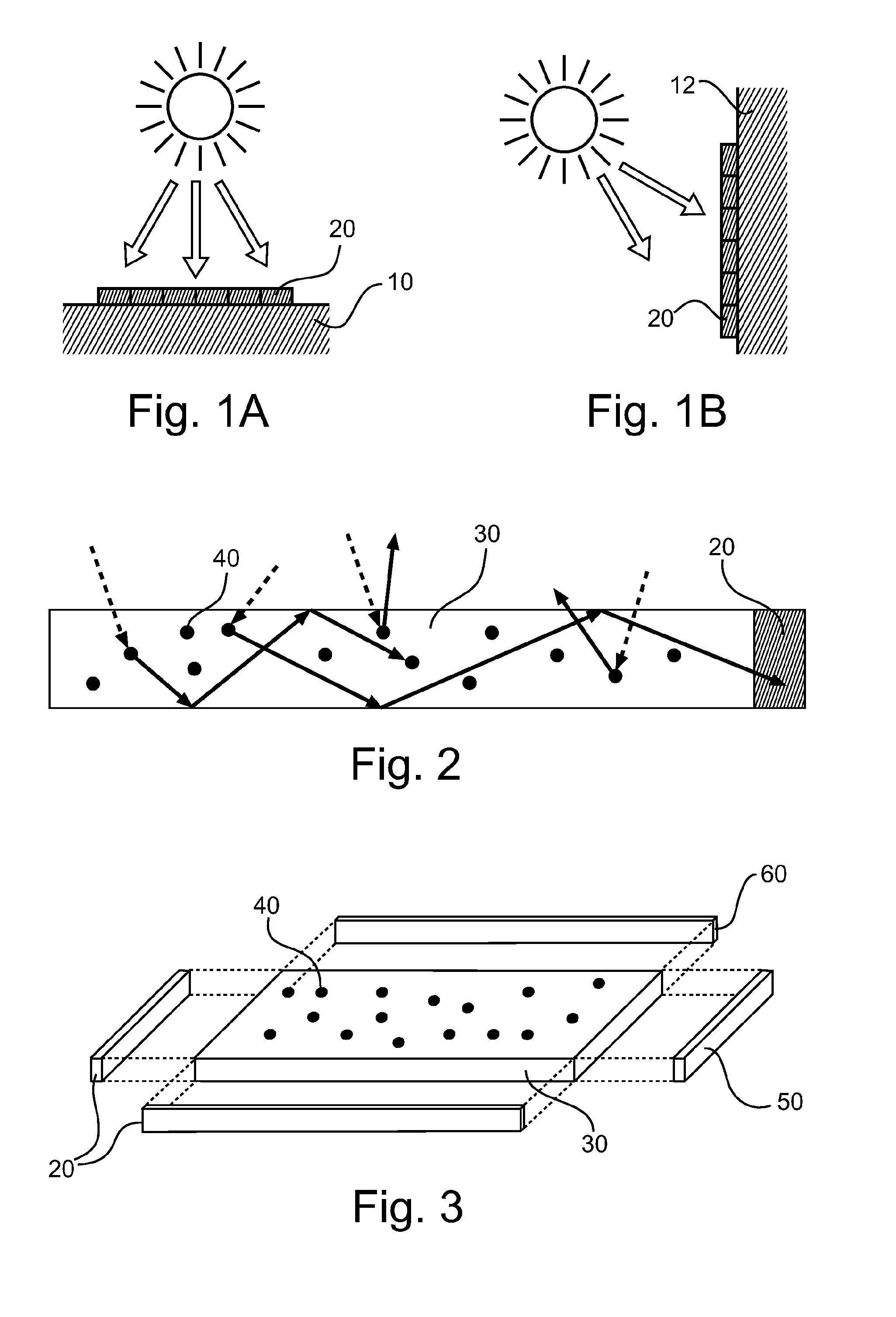Photovoltaic cell device with switchable lighting/reflection
a photovoltaic cell and switchable technology, applied in the field of photovoltaic cell devices, can solve the problems of insufficient efficiency of state-of-the-art lscs to compete with conventional silicon solar cells, and achieve the effect of reducing light absorption and improving efficiency
- Summary
- Abstract
- Description
- Claims
- Application Information
AI Technical Summary
Benefits of technology
Problems solved by technology
Method used
Image
Examples
first embodiment
[0051]FIG. 3 shows a schematic perspective exploded view of a photovoltaic cell device with LSC according to a
[0052]The device comprises a transparent matrix or plate 30 which has a dimension in the vertical z-direction that is significantly smaller compared to the horizontal x and y dimension. In or on top of the transparent plate 30 luminophores 40 are integrated that absorb (solar) irradiation and reemit the light in all directions. To the smaller sides of the transparent plate 30 one or more solar cells 20 are attached. To other smaller sides of the matrix (an array of) one or more LEDs 50 are attached. To the remaining smaller side(s) reflective mirrors 60 may be attached. The energy storage device can be integrated on the back side of the solar cell 20, LED (array) 50, or mirrors 60. The energy storage device may also be a separate component, not integrated in the device.
[0053]The invention disclosed here combines the energy generating capability of LSCs with a lighting applic...
second embodiment
[0060]FIG. 4 shows a schematic perspective exploded view of a photovoltaic cell device with LSC according to a
[0061]The LEDs50 can have a relatively small area and therefore need not to cover one entire side surface of the transparent plate 30. Therefore, in the second embodiment, the LEDs 50 are placed next to either the solar cells 20 or the mirrors 60. In FIG. 4, an exemplary case is shown where the LEDs 50 are placed next to the solar cells 20.
[0062]Depending on the geometry of the transparent plate 30, the efficiency of the solar cells 20, the efficiency and size of the LED 50, and type of application, an optimum can be found in the number of each of these components, and at which sides they are mounted. It may for example be preferred to have the solar cells 20 on the other side of the LEDs 50, or in another embodiment to have the mirrors 60 on the other side of the LEDs.
third embodiment
[0063]FIG. 5 shows a schematic perspective partially exploded view of a photovoltaic cell device with luminescent solar concentrator according to a
[0064]In the third embodiment, depending on the application (e.g. for a non-transparent lamp), it is preferred to also have a back-mirror 65 placed on the bottom (or upper) side of the device, as shown in FIG. 5. In this manner, the (solar) irradiation that is not absorbed by the transparent plate 10 is reflected back into the transparent plate 10 again, where it has another chance to be absorbed. In addition, during the LED operation mode, light emitted by the luminophores 40 can only escape from one side of the transparent plate 30.
[0065]In a specific implementation, the matrix of the transparent plate 30 could be transparent over a range between e.g. 400 and 900 nm, and preferably over a range of e.g. 300-1000 nm. It may consist of a polymer, or a mixture of polymers, such as methylmethacrylate (PMMA), laurylmethacrylate (LMA), 2-hydro...
PUM
 Login to View More
Login to View More Abstract
Description
Claims
Application Information
 Login to View More
Login to View More - R&D
- Intellectual Property
- Life Sciences
- Materials
- Tech Scout
- Unparalleled Data Quality
- Higher Quality Content
- 60% Fewer Hallucinations
Browse by: Latest US Patents, China's latest patents, Technical Efficacy Thesaurus, Application Domain, Technology Topic, Popular Technical Reports.
© 2025 PatSnap. All rights reserved.Legal|Privacy policy|Modern Slavery Act Transparency Statement|Sitemap|About US| Contact US: help@patsnap.com



